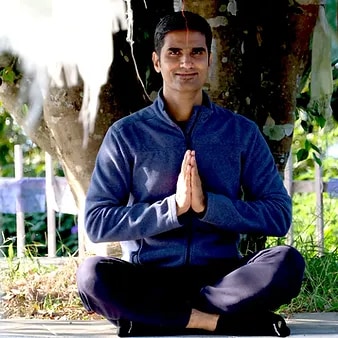Understanding the Second Niyama-Santosha
by Hardik Mehta

The Niyamas, constituting the second limb of the Yoga path, offer a framework for personal observances and practices aimed at fostering inner harmony and spiritual growth. Delving into these principles after understanding the Yamas provides a comprehensive approach to navigating the journey of self-discovery and transformation through Yoga.
In the whirlwind of modern life, where hustle culture often prevails, finding contentment can feel like chasing a fleeting dream. However, rooted in the ancient wisdom of yoga, Santosha, the second Niyama, offers a pathway to inner peace and fulfilment. In this blog, we delve into the essence of Santosha, exploring its significance and practical ways to cultivate contentment in our lives.
Santosha, derived from the Sanskrit words “Sam” meaning completely or entirely, and “Tosha” meaning contentment or satisfaction, embodies the state of being fully content with what is. It’s about finding joy and peace in the present moment, regardless of external circumstances. Santosha doesn’t advocate complacency or resignation but rather a deep acceptance of reality while nurturing an attitude of gratitude and fulfilment.
Santosha specifically emphasizes contentment, satisfaction, and acceptance of one’s present circumstances. Within the context of the Niyamas, Santosha serves as a cornerstone for cultivating inner peace and harmony. It complements other Niyamas such as Saucha (purity), Tapas (discipline), Svadhyaya (self-study), and Ishvara Pranidhana (surrender to the divine), offering a balanced approach to spiritual practice.
In the Yoga Sutras, Patanjali highlights Santosha as a key aspect of inner purification and mental refinement, essential for achieving the state of Yoga (libration) and transcending the fluctuations of the mind (Chitta Vritti Nirodha).
Significance of Santosha
In a world driven by consumerism and comparison, Santosha offers a refreshing perspective. It teaches us to shift our focus from external validation and material possessions towards inner contentment. By cultivating Santosha, we free ourselves from the shackles of desire and discontent, experiencing greater emotional stability and mental clarity.
Practical Ways to Cultivate Santosha
Cultivating Gratitude: Begin each yoga practice with a heart filled with gratitude. Offer thanks for the opportunity to engage in the sacred journey of self-discovery through asana, pranayama, and meditation. Cultivating gratitude fosters a deeper connection with the present moment and opens the heart to receive the abundance of life’s blessings.
Surrendering to the Present Moment: During yoga practice, surrender to the flow of breath and movement, releasing attachment to expectations and outcomes. Allow each posture to unfold organically, embracing the sensations that arise with a sense of curiosity and acceptance. In surrendering to the present moment, we cultivate Santosha in its purest form.
Cultivating Inner Contentment: Beyond the physical aspects of yoga, delve into the realm of inner exploration through self-reflection and introspection. Engage in practices such as mindfulness meditation and self-inquiry to uncover the source of discontent within and cultivate a profound sense of inner contentment that transcends external circumstances.
Practicing Ahimsa (Non-Harming): Extend the principles of Santosha beyond the confines of the yoga mat by practicing Ahimsa, or non-harming, towards oneself and others. Cultivate compassion and kindness in thoughts, words, and actions, nurturing a supportive and harmonious environment conducive to the growth of contentment.
Embracing Seva (Selfless Service): Engage in acts of selfless service, or Seva, as a means of cultivating Santosha in action. Offer your time, skills, and resources to support those in need, recognizing the interconnectedness of all beings and the inherent joy that arises from serving others without expectation of reward.
Benefits of Santosha
The practice of Santosha, or contentment, offers a myriad of benefits that extend beyond mere happiness and satisfaction. Here are some of the key benefits of cultivating Santosha in our lives:
Inner Peace and Serenity: Santosha enables individuals to find peace and serenity within themselves, regardless of external circumstances. By embracing contentment, we reduce the incessant fluctuations of the mind and cultivate a sense of inner calm that remains undisturbed amidst life’s challenges.
Reduced Stress and Anxiety: Contentment acts as a powerful antidote to stress and anxiety. When we learn to accept and appreciate the present moment, we release the grip of worry and fear, allowing ourselves to experience greater ease and relaxation in body and mind.
Enhanced Emotional Well-being: Cultivating Santosha promotes emotional resilience and well-being. By shifting our focus from what we lack to what we already have, we foster a positive outlook on life and cultivate gratitude for the blessings that surround us, leading to greater emotional stability and happiness.
Improved Relationships: Contentment positively impacts our relationships with others. When we are content within ourselves, we approach interactions with a sense of openness, compassion, and generosity. This fosters deeper connections and enhances the quality of our relationships with family, friends, and colleagues.
Greater Self-Acceptance: Santosha encourages self-acceptance and self-love. By embracing contentment, we learn to appreciate ourselves exactly as we are, free from judgment or comparison. This fosters a sense of wholeness and completeness, allowing us to live authentically and confidently.
Increased Resilience: Contentment cultivates resilience in the face of adversity. When we learn to accept life’s inevitable ups and downs with equanimity, we develop greater strength and resilience to navigate challenges with grace and courage.
Enhanced Spiritual Growth: Santosha is integral to spiritual growth and self-realization. By cultivating contentment, we align ourselves with the deeper truths of existence and connect with the innate wisdom and divine essence within. This fosters a deeper sense of connection with the universe and facilitates the journey towards spiritual awakening.
Freedom from Consumerism and Materialism: Embracing Santosha liberates us from the relentless pursuit of external validation and material possessions. By finding contentment within ourselves, we reduce the tendency to seek happiness in material wealth or status, leading to greater freedom and fulfilment.
In the pursuit of happiness, Santosha serves as a guiding light, reminding us that true contentment lies within. By embracing this ancient yogic principle and incorporating practical strategies into our daily lives, we can experience greater joy, peace and fulfilment. Let’s embark on this journey towards Santosha, nurturing a sense of contentment that transcends circumstances and enriches our lives in profound ways.
Sayujya Yoga provides a comprehensive 200-hour TTC program in Mumbai, encompassing yoga philosophy and a holistic approach. Renowned as the best institute in Mumbai, we offer transformative yoga retreats in India. Join us on a journey of self-discovery and inner transformation.
About the Author

Hardik Mehta
Hardik is an E-RYT 500 & YACEP (Yoga Alliance Continuing Education Provider), Yoga Alliance, USA. He has been practicing yoga for the last 9 years. Prior to finding his true calling in Yoga, he was working with various corporates for 12 years in the Retail and eCommerce sector.
